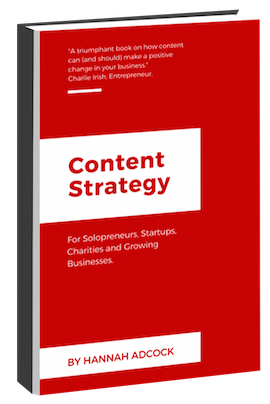Over the last ten years I’ve worked as a writer, editor, proofreader, researcher and project manager. It's been great. I love working with content. However, I've often worked at the edge of companies, bringing content to the party just as it's ending. And in my opinion content doesn't really belong there. It should be the centre of things, a gin and tonic in one hand and someone else's hand in the other. So when I discovered content strategy in 2013, I was hooked.
Discovering Content Strategy
I 'discovered' content strategy by reading two books: Content Strategy for the Web by Christina Halvorson and Melissa Rach and Content Everywhere by Sara Wachter-Boettcher. Wachter-Boettcher talked about dividing content into chunks so it can travel, which made a lot of sense. I've never been a fan of the approach where content – in a semantically indistinguishable mess – is poured into a fixed-size bucket and then abandoned. I have to admit that I've done it myself. I just tended to have reservations. The content quickly becomes outdated; it is also trapped. I read Wachter-Boettcher's book going "yes, totally!" which is quite unusual for me, being usually more reserved and English in my reactions. Halvorson and Rach's book, which is the industry 'bible', was enjoyable for a different reason: it was so practical. By the time I'd finished reading it I thought 'yep, I could do that. Maybe not exactly the same, but on similar lines, most certainly'.
A possible new career
So, together these two books got me interested enough in content strategy that I began to think that here was a possible career. True, content strategy seems a slightly odd choice for someone who's just done a MSc in Global Politics at LSE. But I figured that what I'd loved about the course – and academia in general – was the challenge of constructing a compelling story from various sources and presenting it in a logical and persuasive manner. This isn't really so far from what it takes to create a good content strategy. And if I end up working with NGOs and government bodies then at least I could bring an extra level of understanding to the job.
Doing more with less
Of course there's always a risk that content strategy will remain a fairly niche discipline. There's still plenty of people who see content, particularly copy, as something that needs to be done as cheaply as possible. However, with the rapid pace of change in technology at the moment such an approach has hidden costs. That cluttered homepage might look only slightly bad on a 800x600 screen; it will look horrible on a mobile. That series of tweets might have seemed like a good idea at the time, but they don't link to key business objectives and it's nearly lunchtime. Mediocre content suddenly look like rather poor value.
For me, and I'm certain not the only person who's saying this, the content game is changing. It's not about more content anymore: about more descriptions, more product information, more reviews, more tweets and more blogs. It's about doing more with less. Because, after all, every company only has so much time and money. And, users – those great people who buy or use your products – they only have so much time too.
Content Strategy for Solopreneurs, Startups, Charities and Growing Businesses
This book will help you tackle 12 common business challenges including making sure you're reaching everyone who could be a customer, persuading people to buy from you and not a competitor, and how you can get your team to produce useful usable content. Read more about the ebook.
You'll learn
- How thinking strategically about your content will drive growth
- Practical tips on creating content strategy deliverables that will save you time and money
- How to create a content strategy for your company in 4 weeks
